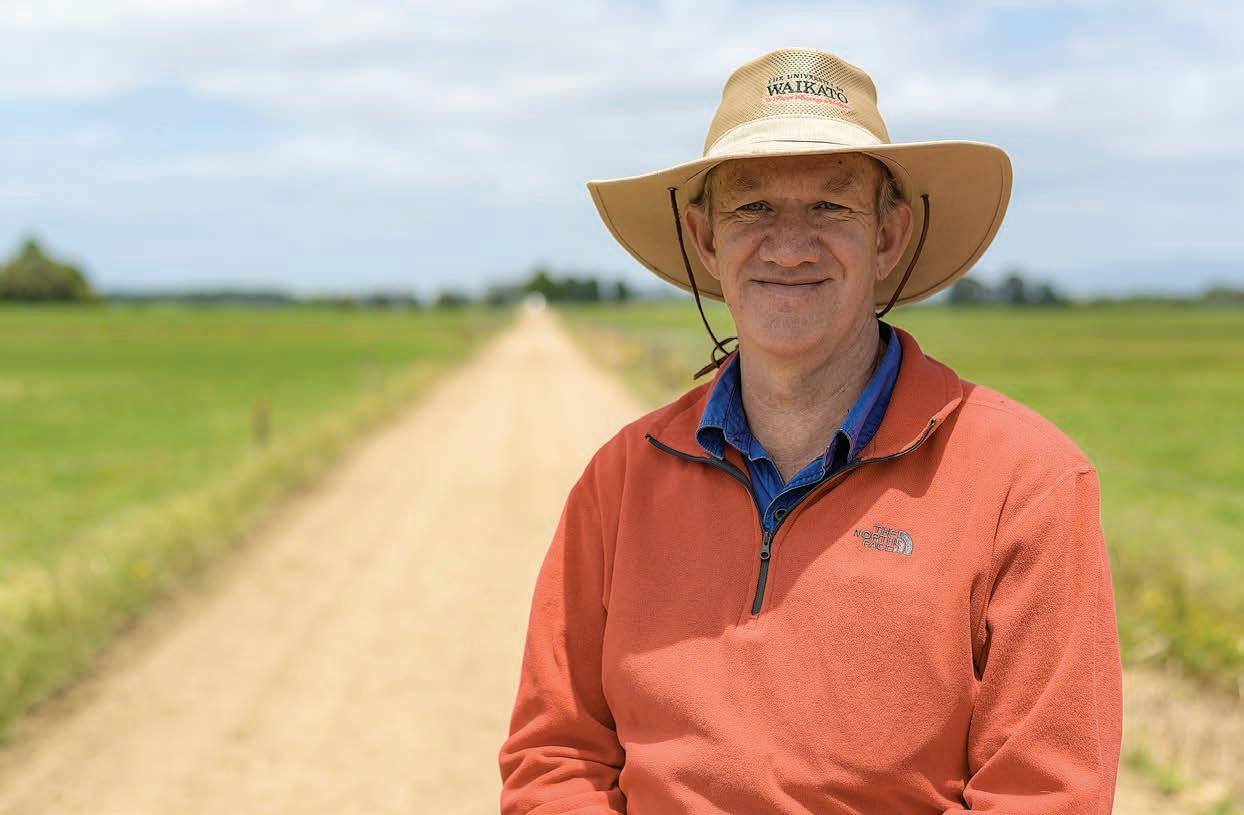
5 minute read
Editorial
Soil carbon influences climate, as well as farm productivity
In the first of three articles about soil carbon, Professor Louis Schipper from the University of Waikato explains why soil carbon matters to farmers, what influences it and what we currently know about carbon stocks in New Zealand’s pastoral soils.
SOIL carbon is one of the most talked-about subjects in agriculture.
That’s not surprising because carbonrich soils support vigorous crop and pasture growth, and may be more resilient to stressors such as drought.
Changes in soil carbon stocks over time might also affect the climate.
Carbon is constantly cycling between the atmosphere, plants and the soil. Globally, there’s a vast amount of carbon stored in the soil – more, in fact, than in the atmosphere and above-ground plants and trees combined.
So, shifting the balance even slightly so that more carbon is drawn from the atmosphere and locked up in the soil could reduce atmospheric carbon dioxide concentrations and mitigate climate change effects.
On the other hand, losing soil carbon back into the atmosphere as carbon dioxide would add to greenhouse gas emissions from other sources.
If you’re interested in the science of the carbon cycle, there’s an excellent explanation on the Ag Matters website.
It’s understandable, then, that many farmers want to learn how to increase their soil carbon stocks, or at least hold on to what they’ve got.
There are many ideas in circulation, but what do we know for sure?
We know that soil carbon stocks and composition can vary greatly over time and space (even within a single paddock).
We know that environmental factors, such as climate, topography and soil type, are significant influences.
We know that land-use change, for example converting from forest to pasture or vice-versa, affects soil carbon stocks.
And, we know that some practices, such as leaving soils bare for long periods, result in soil carbon losses.
But, when land use doesn’t change, are there management practices that farmers can use to maintain or increase their stocks?
That’s the critical question. And unfortunately, despite a lot of anecdotal evidence doing the rounds at the moment, the scientific jury for NZ soils is still out.
The research needed to determine whether soil carbon stocks are increasing or decreasing, and what’s causing the change, is complex.
NZ-specific research, funded by the New Zealand Agricultural Greenhouse Gas Research Centre,
The Pulpit

RESEARCH: Professor Louis Schipper co-leads the Plants and Greenhouse Gases science programme funded and coordinated by the New Zealand Agricultural Greenhouse Gas Research Centre.
is continuing and I’ll have more on that in my next article.
However, until further results are available, we can’t definitively recommend any individual management practices that farmers can use to maintain or increase their soil carbon. Minimising the length of time that soils are bare is the most practical management option available to farmers right now.
We can’t rely fully on research from overseas either, because the situation in NZ is different from other parts of the world where some farmers have been able to significantly increase soil carbon stocks.
Farmers and scientists need to consider all the influences I’ve mentioned to gain a clear picture of how New Zealand’s soil carbon stocks measure up, how they’re changing, and what’s contributing to that change. We need robust data from across space and time.
There is, however, enough highquality data available now to draw a general picture of soil carbon stocks and stock changes under NZ’s pastoral land.
The data tells us our carbon stocks are generally high, averaging about 106 tonnes of carbon per hectare in the top 30cm.
That’s higher than the carbon stocks of carbon-depleted agricultural land in many other countries.
In Australia, for example, carbon stocks are about 30t/ha
There are several reasons for this, including the age, chemical make-up and physical properties of our soils, our temperate climate and good management by our farmers over many years.
And recent sampling suggests that, very broadly, stocks under grazed pastures on flat-rolling land in NZ haven’t changed much in the last two to three decades.
Drained peat soils are a notable exception. They continue to lose carbon, and this is the case for many farmed peat soils globally.
There’s also some evidence that hill country grassland soils have gained carbon during this time. We’re still investigating how widespread the gains are, and whether they’re continuing.
Because NZ’s agricultural land is in this comparatively favourable position, it’s much harder to add to our soil carbon stocks than it is in some other parts of the world where intensive farming practices, like continuous cropping, have resulted in large carbon stock declines.
So, are there any novel practices that NZ farmers might be able to try in the future to maintain or increase their soil carbon stocks? In my next article, I’ll look at some of the ideas that scientists are exploring.
Who am I?
Professor Louis Schipper is an environmental biogeochemist at Waikato University. His research interests include long-term changes in soil organic matter, nitrogen cycling, impacts of land-use change, carbon fluxes and nutrient cycling in agricultural and indigenous ecosystems.
Your View
Got a view on some aspect of farming you would like to get across? The Pulpit offers readers the chance to have their say. farmers.weekly@globalhq.co.nz Phone 06 323 1519
Brookfi eld ‘thick skinned’ Romneys

I’ve got three sons in the sire mob now. 580 keeper ewe hoggets scanned scanned 112% this year. Our thickest skinned ram hoggets had 5 mls skins this year and our thinnest 1.7 mls. Guess where he is now?









